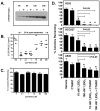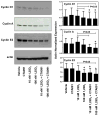CYP24 inhibition preserves 1α,25-dihydroxyvitamin D(3) anti-proliferative signaling in lung cancer cells
- PMID: 22386975
- PMCID: PMC3312998
- DOI: 10.1016/j.mce.2012.02.006
CYP24 inhibition preserves 1α,25-dihydroxyvitamin D(3) anti-proliferative signaling in lung cancer cells
Abstract
Human lung tumors aberrantly express the 1α,25-dihydroxyvitamin D(3) (1,25(OH)(2)D(3))-catabolizing enzyme, CYP24. We hypothesized that CYP24 reduces 1,25(OH)(2)D(3)-mediated transcription and allows lung cancer cells to escape its growth-inhibitory action. To test this, H292 lung cancer cells and the CYP24-selective inhibitor CTA091 were utilized. In H292 cells, CTA091 reduces 1,25(OH)(2)D(3) catabolism, significantly increases 1,25(OH)(2)D(3)-mediated growth inhibition, and increases 1,25(OH)(2)D(3) effects on induced and repressed genes in gene expression profiling studies. Pathway mapping of repressed genes uncovered cell cycle as a predominant 1,25(OH)(2)D(3) target. In H292 cells, 1,25(OH)(2)D(3) significantly decreases cyclin E2 levels and induces G(0)/G(1) arrest. A broader set of cyclins is down-regulated when 1,25(OH)(2)D(3) is combined with CTA091, and cell cycle arrest further increases. Effects of CTA091 on 1,25(OH)(2)D(3) signaling are vitamin D receptor-dependent. These data provide evidence that CYP24 limits 1,25(OH)(2)D(3) anti-proliferative signaling in cancer cells, and suggest that CTA091 may be beneficial in preserving 1,25(OH)(2)D(3) action in lung cancer.
Copyright © 2012 Elsevier Ireland Ltd. All rights reserved.
Figures





Similar articles
-
Differential response to 1α,25-dihydroxyvitamin D3 (1α,25(OH)2D3) in non-small cell lung cancer cells with distinct oncogene mutations.J Steroid Biochem Mol Biol. 2013 Jul;136:264-70. doi: 10.1016/j.jsbmb.2012.09.022. Epub 2012 Sep 28. J Steroid Biochem Mol Biol. 2013. PMID: 23026510 Free PMC article. Review.
-
A local effect of CYP24 inhibition on lung tumor xenograft exposure to 1,25-dihydroxyvitamin D(3) is revealed using a novel LC-MS/MS assay.Steroids. 2012 Apr;77(5):477-83. doi: 10.1016/j.steroids.2012.01.007. Epub 2012 Jan 20. Steroids. 2012. PMID: 22285938 Free PMC article.
-
Vitamin D analogues targeting CYP24 in chronic kidney disease.J Steroid Biochem Mol Biol. 2010 Jul;121(1-2):13-9. doi: 10.1016/j.jsbmb.2010.03.065. Epub 2010 Mar 27. J Steroid Biochem Mol Biol. 2010. PMID: 20347976
-
Effects of MAPK signaling on 1,25-dihydroxyvitamin D-mediated CYP24 gene expression in the enterocyte-like cell line, Caco-2.J Cell Physiol. 2009 Apr;219(1):132-42. doi: 10.1002/jcp.21657. J Cell Physiol. 2009. PMID: 19097033 Free PMC article.
-
Combination of vitamin D metabolites with selective inhibitors of vitamin D metabolism.Recent Results Cancer Res. 2003;164:169-88. doi: 10.1007/978-3-642-55580-0_13. Recent Results Cancer Res. 2003. PMID: 12899522 Review.
Cited by
-
Differential response to 1α,25-dihydroxyvitamin D3 (1α,25(OH)2D3) in non-small cell lung cancer cells with distinct oncogene mutations.J Steroid Biochem Mol Biol. 2013 Jul;136:264-70. doi: 10.1016/j.jsbmb.2012.09.022. Epub 2012 Sep 28. J Steroid Biochem Mol Biol. 2013. PMID: 23026510 Free PMC article. Review.
-
Calcitriol Inhibits Cervical Cancer Cell Proliferation Through Downregulation of HCCR1 Expression.Oncol Res. 2014;22(5-6):301-9. doi: 10.3727/096504015X14424348425991. Oncol Res. 2014. PMID: 26629942 Free PMC article.
-
Progesterone potentiates the growth inhibitory effects of calcitriol in endometrial cancer via suppression of CYP24A1.Oncotarget. 2016 Nov 22;7(47):77576-77590. doi: 10.18632/oncotarget.12725. Oncotarget. 2016. PMID: 27769055 Free PMC article.
-
Vitamin D-Related Gene Polymorphisms, Plasma 25-Hydroxy-Vitamin D, Cigarette Smoke and Non-Small Cell Lung Cancer (NSCLC) Risk.Int J Mol Sci. 2016 Sep 22;17(10):1597. doi: 10.3390/ijms17101597. Int J Mol Sci. 2016. PMID: 27669215 Free PMC article.
-
Pan-Cancer Analysis Confirms the Prognostic and Immunological Implications of the 1,25-Dihydroxy Vitamin D3 Receptor in Cervical Squamous Cell Carcinoma.Cureus. 2024 Aug 12;16(8):e66743. doi: 10.7759/cureus.66743. eCollection 2024 Aug. Cureus. 2024. PMID: 39268267 Free PMC article.
References
-
- Abertson DG, Yistra B, Segraves R, Collins C, Dairkee SH, Kowbel D, Kuo WL, Gray JW, Pinkel D. Quantitative mapping of amplicon structure by array CGH identifies CYP24 as a candidate oncogene. Nature Genetics. 2000;25:144–146. - PubMed
-
- Anderson MG, Nakane M, Ruan X, Kroeger PE, Wu-Wong JR. Expression of VDR and CYP24A1 mRNA in human tumors. Cancer Chemother Pharmacol. 2006;57:234–240. - PubMed
-
- Banach-Petrosky W, Ouyang X, Gao H, Nader K, Ji Y, Suh N, DiPaola RS, Abate-Shen C. Vitamin D inhibits the formation of prostatic intraepithelial neoplasia in Nkx3.1; Pten mutant mice. Clin Cancer Res. 2006;12(19):5895–5901. - PubMed
-
- Beer DG, Kardia SL, Huang CC, Giordano TJ, Levin AM, Misek DE, Lin L, Chen G, Gharib TG, Thomas DG, Lizyness ML, Kuick R, Hayasaka S, Taylor JM, Iannettoni MD, Orringer MB, Hanash S. Gene-expression profiles predict survival of patients with lung adenocarcinoma. Nat Med. 2002;8(8):816–824. - PubMed
Publication types
MeSH terms
Substances
Grants and funding
LinkOut - more resources
Full Text Sources
Medical

